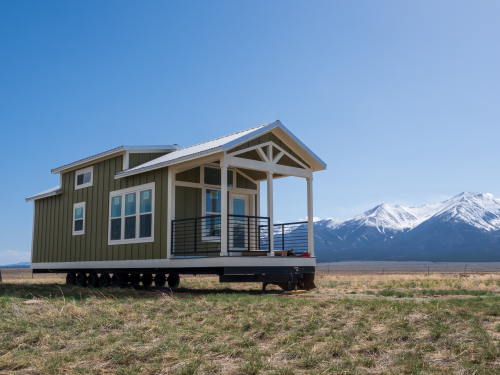In a leaky, drafty former VFW hall on Milwaukee’s northwest side, Pastor Gerald Saffold is busy rebuilding civil society. Of course, that’s not how he would describe what he’s doing. He would say that he’s bringing souls to Christ—using his gift for music to draw inner-city teens into his “Unity in the Community” Choir, where former gang leaders and drug dealers help him write the songs and choreograph the dances they then perform all over the city.
Nonetheless, here is an unmistakable act of civic renewal, and under the least hospitable circumstances imaginable. Where before there were inner-city gangs of radically alienated, angry teens, there is emerging today a cohesive community, united in common endeavor, mutually developing skills of cooperation, leadership, and citizenship.
Yet, sadly, we as a society do not seem inclined to celebrate this simple gospel choir as a significant civic event. (And this, ironically, in the very face of Professor Robert Putnam’s now famous discovery of the link between active choral societies and civic health.) Instead, we seem to be scanning the horizon for larger countrywide movements, for a sweetening of our collective national mood, a restoration of national cohesiveness.
How did we arrive at this preoccupation with national cohesiveness? That is the story of the idea of national community—the central concept and overriding goal of 20th-century American progressive liberalism. Early in the 20th century, our leading political intellectuals—foremost among them Walter Lippmann, Herbert Croly, and John Dewey—concluded that the forces of modernity were rapidly and irretrievably eroding the traditional institutions of civil society. Within such institutions—small towns, churches, neighborhoods, and ethnic and religious groups—Americans had traditionally governed themselves, established and preserved their own vigorous moral and religious cultures, cared for their most vulnerable, and met the human yearning for community.
But now, the progressives warned, the boundaries of these “island communities” had been hopelessly ruptured by modern technologies—the railroad, telegraph, telephone, the high-speed press, the corporation. These same technologies, however, made possible a new and dramatically improved form of community—the great national community. Elaborate communications and transportation networks would pull the nation together even as they pulled the village apart. And the emerging social sciences would tame the disintegrative sociological and psychological effects of modernity, once enough experts in government, business, and the nonprofit sector were trained in them and organized into the imposing bureaucracies that would now “scientifically manage” all human affairs.
To bring comprehensive order to all these forces, Theodore Roosevelt proclaimed in 1912, we now required a far more powerful central government. At the apex of this new federal apparatus, a dynamic, articulate president would mount the “bully pulpit” and summon the American people out of modernity’s fragmented individualism into unified, high-minded national endeavor. The stirring rhetoric of national crisis and war would provide the metaphors needed to make the American people sense, as the late Robert Nisbet put it, “their mystic national oneness.”
This century’s political life has been dominated by the project of building a great national community or family or village, peaking in Lyndon Johnson’s effort to “turn unity of interest into unity of purpose, and unity of goals into unity in the Great Society.” We have been exhorted by Franklin Roosevelt to unite in the face of the Great Depression “as a trained and loyal army willing to sacrifice for the good of a common discipline;” by John F. Kennedy to “ask not what our country can do for us, but what we can do for our country;” by Lyndon Johnson to wage a “war on poverty.” Through these galvanizing metaphors of war and crisis, the presidency sought to fulfill its primary purpose, which is, as Walter Mondale put it in 1984, to “make us a community and keep us a community.”
As noble as this ideal may seem—as necessary as national unity may be in the face of genuine emergencies or war—progressivism’s national community has proven in political practice to be this century’s greatest disappointment. Though it has drained the strength and moral authority from local community institutions, it has failed to build the promised national substitute.
The national community’s contempt for and campaign to eradicate local civic institutions is a bedrock of 20th-century elite discourse. Local institutions, it is said, are notoriously and hopelessly backward, partial, parochial, reactionary, and riddled with irrational myths and prejudices. They cling stubbornly to obscure and retrograde notions of traditional morality and religious faith, rather than bowing sensibly to the authority of scientifically credentialed professionals and experts, who alone can exploit the potential of modernity.
How many campus-bred intellectual doctrines, how many short stories and novels, how many Hollywood movies and television shows, have reveled in this contrast between shabby, small-minded, local prejudices and a sophisticated, expansive attachment to national ideals? Given the unremitting hostility of America’s elites throughout this century, is it any wonder that local civic institutions might today find themselves in an uphill struggle for survival?
That the idea of national community has failed to deliver on its central promise—to reestablish at the level of the nation as a whole the sense of belonging, purpose, and self-governance that local institutions once provided—is now commonly considered a conservative argument. But the insight by no means originated on the right. Indeed, as Nisbet pointed out, conservatism wasted much of this century futilely extolling the virtues of rugged individualism and the untrammeled marketplace in the face of America’s manifest yearning for some form of community.
Rather, the bankruptcy of the idea of national community was the central insight of the New Left of the 1960s and of Saul Alinsky’s community organizers, before and since. They initially and correctly observed that the Great Society had not in fact delivered the great community, but rather only the cold, distant, alienated bureaucracies of “corporate liberalism.” The vast, impersonal institutions of business and government, they argued, simply could not provide the self-governance and community of “participatory democracy” for which the human spirit yearned.
Conservatism has indeed more recently taken up this general theme, though not at all in the spirit of the ?60s. To be sure, participatory democracy is essential for human happiness, conservatism maintains, but the peculiarly American way of achieving it has always been through dutiful citizenship within traditional, local institutions like the church, neighborhood, and voluntary association. That Republican presidents were swept into office throughout the past three decades on this theme proved its power; that a Democratic president recently won reelection on this same theme marks its moment of supreme triumph.
But the subtle allure of the national community idea is still very much evident today and tends to undermine even the most sincere efforts to restore civic institutions. Our national ambivalence is nicely reflected in Hillary Rodham Clinton’s recent It Takes a Village.
Ms. Clinton readily concedes what progressivism had denied for much of this century—that strong families, neighborhoods, and churches, far from being merely nurseries of reaction and bigotry, are essential to the physical, psychological, and moral well-being of children. That stated, however, she quickly reverts to themes more congenial to the project of national community: that such traditional local institutions have been hopelessly undercut by technology; that we therefore must now rely heavily on the advice and assistance of trained professionals and experts; and that we should consider a variety of new government institutions to ensure that all families are able to secure such advice and assistance. The small, real-life village quickly yields to the metaphorical national village.
Likewise, discussions of revitalizing civil institutions tend to focus on a limited range of major national nonprofits like the PTA or the Red Cross, which are by no means incompatible with the idea of national community. Though these organizations may have local chapters, they often look to the Washington office for marching orders, receive federal funding, press policy agendas on the federal government, and have gradually displaced the leadership of local amateurs and volunteers with centralized bureaucracies of scientifically trained experts and professionals. Such “acceptable” civic institutions can even be counted on to go before congressional committees and testify that they would languish, rather than prosper, were government’s benevolent presence to be diminished any further.
It is now permissible—indeed, fashionable—to fret about the health of such organizations, because of course they do not at all undermine, but rather tend to reinforce, the upward political tug of the national community idea. It is seldom noted that perhaps their health is imperiled precisely because they have exchanged their historic roots in the neighborhood for invitations to cocktails in the salons of our political and cultural elites. Perhaps their predicament is not a proper gauge of the well-being of American civil society after all.
These examples suggest that while the moral authority of the idea of national community has been seriously eroded over the past several decades, it has nonetheless left in its wake towering bureaucracies of elites and experts—not only within government, but in the nonprofit sector as well—who have powerful vested interests in the renationalization of the idea of community. As they argue eloquently and forcefully, “civic renewal” means restoring the deference and respect owed by a mystifyingly ungrateful public to the major institutions working on behalf of the noble idea of national community.
I would suggest, on the contrary, that it’s time to look in the opposite direction, away from the exhausted ideal of national community and toward the small but vigorous civic community that Pastor Saffold is building on Milwaukee’s northwest side. As Bob Woodson has argued so forcefully over the years, there are in fact hundreds of Saffolds in America’s inner cities, working quietly, successfully, and without public acclaim to battle drug abuse, educate children, reclaim teens from gangs, and rebuild neighborhood economies—in other words, to accomplish as small, local civic institutions what government bureaucracies never could.
Throughout our nation faith-based grass-roots leaders are managing—at a time and in places where the bureaucracies of business and government and the mainstream nonprofits have thrown up their hands and fled—to resurrect the institutions and principles of civil society. They are civil society’s trauma specialists—and the true experts on civic renewal.
Yet to our elites, these grass-roots initiatives are invisible, or if visible, dismissed as charismatic exceptions or inspiring but isolated anecdotes. After all, they’re not docile subsidiaries of the larger, “acceptable” nonprofits, but rather scrappy, scruffy, fiercely independent local initiatives, too busy working with the poor to join coalitions against poverty. They are not staffed by credentialed bureaucrats, but by volunteers whose chief credential may be that they themselves have only recently overcome the daunting circumstances of the inner city. They place little faith in the rehabilitative powers of the social sciences, but witness every day the fruits of their faith in the transformative power of God.
The disdain of elites notwithstanding, we should heed the wisdom of these grass-roots leaders who have, against heavy odds, accomplished the civic revival that we wish for all our communities. We should appreciate them, honor them, celebrate them. We should also highlight the ways in which private and public resources can be redirected to those who have already accomplished so much with virtually no outside help at all. Here the federal government should have a role too—not as grand builder of national community, but as humble servant to the genuine community-builders within our neighborhoods.
When the VFW decided a while back to close its hall on Milwaukee’s northwest side, no doubt that retreat of a major national nonprofit was carefully toted up as one more loss on Professor Putnam’s gloomy balance sheet of civil society. When Gerald Saffold once again filled the old hall with joyous music, no doubt that vigorous advance of civic renewal went unrecorded. It is past time to direct our gaze away from the failed project of national community and focus once again on the churches, voluntary associations, and grass-roots groups that are rebuilding America’s civil society one family, one block, one neighborhood at a time.


Commentary
Local Groups are the Key to America’s Civic Renewal
September 1, 1997